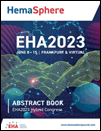PB2621: TREATMENT OF IMMUNE THROMBOCYTOPENIA WITH HETROMBOPAG—A SINGLE-CENTER RETROSPECTIVE, OBSERVATIONAL STUDY
Abstract Topic: 32. Platelet disorders
Background: Clinical practice guidelines have recommended the use of a thrombopoietin receptor agonist (TPO-RA) as a second-line treatment for immune thrombocytopenia (ITP). Hetrombopag is a novel, small molecule, oral non-peptide TPO-RA. In June 2021, hetrombopag received approval in China for the treatment of patients with ITP and severe aplastic anemia (SAA). A phase III clinical trial showed that 64.3% (n=171) of patients in hetrombopag 5 mg group had platelet counts (PLT count) of ≥50 × 109/L in ITP treatment after 8 weeks. However, data on herombopag in the real-world setting is still rare.
Aims: To evaluate the efficiency and safety of hetrombopag monotherapy or combination therapy for relapsed/refractory ITP.
Methods: From July 2021 to February 2023, data from patients diagnosed with refractory/relapsed ITP who had been treated with hetrombopag in Henan Cancer Hospital were analyzed retrospectively. The initial dose of 2.5 mg, 5 mg, or 7.5 mg/d of hetrombopag was given according to the patient’s clinical history and characteristics (e.g., age, PLT counts, and bleeding risk). Subsequent dose adjustments are based on PLT counts, with a maximum of 7.5 mg/d. Response criteria: ①Complete response (CR): PLT count ≥ 100 × 109/L and absence of bleeding. ②Partial response (PR): PLT count ≥ 30 ×109/L and at least twice the baseline PTL count.
Results: A total of 29 patients (20 adults) were enrolled, including 12 males and 17 females; Of whom, 16 patients met the criteria for severe ITP. The median age was 30 (range, 9 to 61 years), and the median baseline PLT count was 9 ×109/L (range, 0 to 28 × 109/L). The median initial dose was 5 mg/d, with 20 patients receiving 5 mg/d, 7 receiving 7.5 mg/d and 2 (children) receiving 2.5 mg/d. The median time to first response (platelet count≥30×109/L) since treatment was 9 days (range 3-15 days), with 10 (34.5%) patients achieving a response ≤ 7d and 11(38.0%) having ≤ 2 weeks. After the first month, 34.5% (10/29) achieved CR, and 44.8% (13/29) achieved PR. Therefore, a total of 79.3% (23/29) of patients had an overall response (OR) to hetrombopag. Among them, 2 patients relapsed, 1 patient discontinued due to economic reasons, and other patients (86.9%) maintained treatment. 10 patients had at least six months of treatment with hetrombopag, and the median maximum continuous duration of response was 65 days (SD 61.49). For 16 patients with severe ITP, 7 achieved CR, 5 achieved PR and 4 had no response, making the OR rate 75%. For the treatment strategies, 10 (34.5%) patients received combination therapy of herombopag and other drugs (8/10 were immunosuppressant agents). During the treatments, 1 patient had increased transaminase and recovered after hepatoprotective treatment, and 1 patient had cerebral venous sinus thrombosis, his condition improved after treatment, and subsequently received replacement treatment with other TPO-RA.
Summary/Conclusion: Hetrombopag can achieve a durable response with good tolerance in patients with relapsed/refractory ITP and may represent a new second-line treatment option for these patients. According to this real-world data, 5 mg/d is the recommended initial dose of hetrombopag in the treatment of adults and overweight children, which can faster increase PLT count and reduce bleeding risk.
Keywords: Immune thrombocytopenia (ITP), Real world data, Thrombopoietin (TPO)




